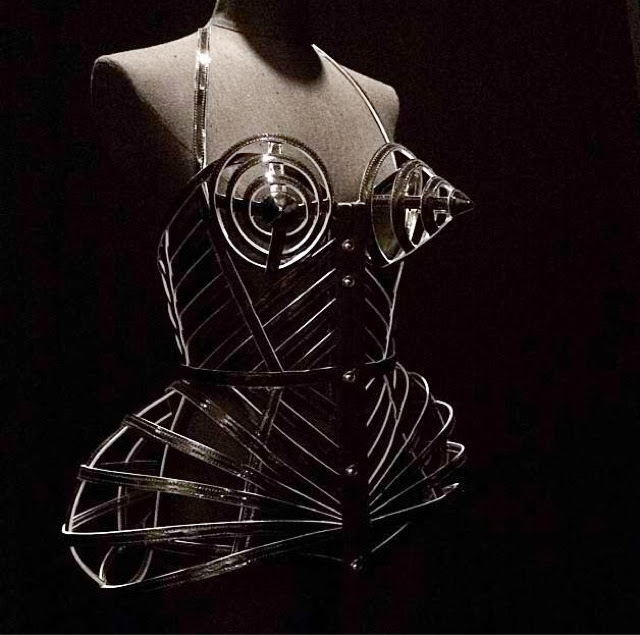I love the way the hip is unaltered creating a more sinched look at the waist as well as the small ruffled details and the elastic garters. The only thing i hate to have to change would most definitely be the bust. From what i can tell by the bone placement of the 1905 corset they are positioned at an angle in the direction of the princes line coming from the back this was to purposely distribute all the fat from the sides to the front creating a more fuller bust. I will be working with a bust that 42" at the largest point with an 33" under bust and a 25" natural waist. Trying to stay true to the design from the original "French plunge front corset " will be a challenge but look at Dita in what i think to be a Mr. Pearl corset also inspired by the 1905 corset.
Love Me Tye
Wednesday, February 12, 2014
Recreating a French plunge front corset from 1905:
Recreating a French plunge front corset from 1905:
I love the way the hip is unaltered creating a more sinched look at the waist as well as the small ruffled details and the elastic garters. The only thing i hate to have to change would most definitely be the bust. From what i can tell by the bone placement of the 1905 corset they are positioned at an angle in the direction of the princes line coming from the back this was to purposely distribute all the fat from the sides to the front creating a more fuller bust. I will be working with a bust that 42" at the largest point with an 33" under bust and a 25" natural waist. Trying to stay true to the design from the original "French plunge front corset " will be a challenge but look at Dita in what i think to be a Mr. Pearl corset also inspired by the 1905 corset.
I love the way the hip is unaltered creating a more sinched look at the waist as well as the small ruffled details and the elastic garters. The only thing i hate to have to change would most definitely be the bust. From what i can tell by the bone placement of the 1905 corset they are positioned at an angle in the direction of the princes line coming from the back this was to purposely distribute all the fat from the sides to the front creating a more fuller bust. I will be working with a bust that 42" at the largest point with an 33" under bust and a 25" natural waist. Trying to stay true to the design from the original "French plunge front corset " will be a challenge but look at Dita in what i think to be a Mr. Pearl corset also inspired by the 1905 corset.
Monday, January 27, 2014
Thursday, December 19, 2013
Tuesday, December 10, 2013
Sunday, December 8, 2013
Friday, December 6, 2013
Metal Corsets in the 16th century
Metal corset (also known as iron corset) is historical type of corset made mostly or entirely out of metal, usually iron.
By the start of the 16th century, Spanish fashions influenced Italian and English ladies. An iron hinged armour like corset was worn to flatten the body giving a smooth outline beneath gowns.
The iron corset must have been exceptionally uncomfortable and heavy to wear and could only have been worn by Elizabethan ladies not doing any form of heavy work. Their only benefit seems to be that they produced the incredibly small waisted, elongated flat chested smooth line torso.
This was illustrated in paintings of great Elizabethan ladies wearing fabulous structured bejewelled gowns. Left - Elongated boyish flattened torso of Queen Elizabeth 1 in the long Elizabethan era - 1592/3. Held at National Portrait Gallery London.
Corsets of the late 16th century would be more recognizable to us today than the iron version. These later corsets incorporated materials such as whalebone, bone, wood and flexible steel. The patterns on the corsets showed the placement of the chosen support and were elongated after a fashion trend set by the boyish figure of Queen Elizabeth I.[1]
Due to large amount of metal used, such corsets were heavy and more uncomfortable than ordinary fabric corsets. They were also padded underneath like armour. The metal corsets also worked like a bulletproof vest, because assassinations by knife attacks were a common risk at the time.
Some sources attribute the introduction of the iron corset to Catherine de Medici, wife of Henry II of France (1579–1589). It was said that she frowned upon anyone having a thick waist and introduced a rigid hardened stiff corset as well as the iron corset. Other sources believe that the 'iron' corset was only intended for remedial wear or for women with physical deformities.
Subscribe to:
Comments (Atom)














































